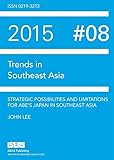Strategic Possibilities and Limitations for Abe's Japan in Southeast Asia / John Lee.
Material type: TextPublisher: Singapore : ISEAS Publishing, [2015]Copyright date: 2015Description: 1 online resource (30 p.)Content type:
TextPublisher: Singapore : ISEAS Publishing, [2015]Copyright date: 2015Description: 1 online resource (30 p.)Content type: - 9789814620901
- 9789814620918
- China—Foreign relations—Japan
- Japan—Foreign relations—China
- Japan—Foreign relations—Southeast Asia
- Japan—Foreign relations—United States
- Southeast Asia—Foreign relations—Japan
- Southeast Asia—Strategic aspects
- United States—Foreign relations—Japan
- International Relations
- POLITICAL SCIENCE / International Relations / General
- 327.52051 22
- DS849.S644 L44 2015
- online - DeGruyter
| Item type | Current library | Call number | URL | Status | Notes | Barcode | |
|---|---|---|---|---|---|---|---|
 eBook
eBook
|
Biblioteca "Angelicum" Pont. Univ. S.Tommaso d'Aquino Nuvola online | online - DeGruyter (Browse shelf(Opens below)) | Online access | Not for loan (Accesso limitato) | Accesso per gli utenti autorizzati / Access for authorized users | (dgr)9789814620918 |
Frontmatter -- FOREWORD -- Strategic Possibilities and Limitations for Abe’s Japan in Southeast Asia
restricted access online access with authorization star
http://purl.org/coar/access_right/c_16ec
Prime Minister Shinzo Abe's desire for Japan to play a more proactive role in strategic affairs stems largely from not just his concern about the nature of China's rise but the challenge to the post-war liberal regional order that the latter's rise and behaviour presents. Any disruption to that order is perceived to be extremely detrimental to Japan's core national interest. The concern with reinforcing and strengthening the existing regional order is causing Japan to take far greater strategic interest in Southeast Asia and also reflects lessons learnt from Abe's first time in office (2006-07). The increased Japanese strategic interest in Southeast Asia is welcomed by all key states in Southeast Asia and the United States, meaning that the growing Japan-Southeast Asian strategic dynamic is mutually reinforcing. Japanese desire to play a more proactive strategic role in Southeast Asia needs to be understood alongside its post-war constitutional limitations. There is strong potential and promising possibilities for Japan to play a more proactive multilateral role in Southeast Asia through its standing and participation in regional institutions (especially ASEAN-led or backed institutions) that will further Tokyo's objectives and advance the strategic and security goals of key Southeast Asian states. Japan's capacity to significantly enhance its strategic role in the region ultimately depends on the success of Abe's domestic reforms.
Mode of access: Internet via World Wide Web.
In English.
Description based on online resource; title from PDF title page (publisher's Web site, viewed 19. Oct 2024)


